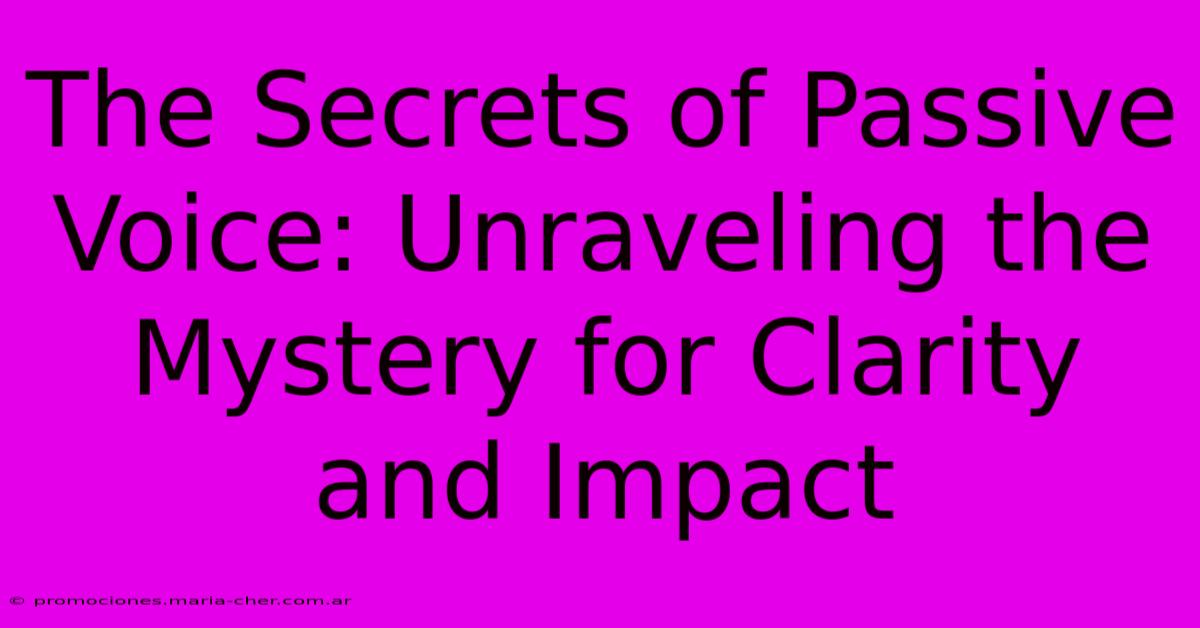The Secrets Of Passive Voice: Unraveling The Mystery For Clarity And Impact

Table of Contents
The Secrets of Passive Voice: Unraveling the Mystery for Clarity and Impact
Passive voice. The phrase itself often evokes groans from grammar enthusiasts and writing instructors. But is it truly the villain it's often made out to be? The truth is more nuanced. While overuse can muddy your writing, understanding the secrets of passive voice—when to use it and when to avoid it—can significantly enhance clarity and impact. This guide unravels the mystery, equipping you with the knowledge to wield passive voice strategically for powerful communication.
Understanding the Passive Voice Construction
Before we delve into the strategic use of passive voice, let's refresh our understanding of its structure. Passive voice occurs when the subject of the sentence receives the action rather than performing it. The sentence typically includes a form of the verb "to be" (is, are, was, were, been, being) and a past participle.
Example:
- Active: The dog chased the ball. (Subject: dog; Verb: chased; Object: ball)
- Passive: The ball was chased by the dog. (Subject: ball; Verb: was chased; Agent: dog)
Notice how the object of the active sentence ("the ball") becomes the subject of the passive sentence. The actor ("the dog") can be included (as shown) or omitted entirely.
When to Embrace the Passive Voice
Despite its often-negative reputation, passive voice has its place. Mastering its strategic application can elevate your writing. Here are key scenarios where it shines:
1. Emphasizing the Action, Not the Actor
When the action itself is more important than who performed it, passive voice is ideal.
Example: "Mistakes were made." This classic phrase avoids assigning blame and focuses on the errors themselves.
2. De-emphasizing the Actor
Sometimes, the actor is unimportant, unknown, or needs to be downplayed for various reasons.
Example: "The window was broken." It might be irrelevant who broke the window; the focus is on the damage.
3. Creating a More Formal Tone
Passive voice often lends itself to a more formal and objective style, common in academic writing, scientific reports, and legal documents.
Example: "The experiment was conducted under controlled conditions." This sentence is more formal than "We conducted the experiment under controlled conditions."
4. Avoiding Wordiness
In certain instances, using the passive voice can lead to a more concise sentence structure.
Example: Instead of "The committee decided that the proposal should be approved," you could write "The proposal was approved by the committee." (Though in this example, the active voice is often preferable for clarity.)
When to Avoid Passive Voice
While passive voice offers advantages, overusing it can significantly detract from your writing. It can:
- Weaken your writing: Passive voice often makes your writing sound weaker and less direct.
- Create ambiguity: Omitting the actor can sometimes make it unclear who or what performed the action.
- Make your writing longer and more cumbersome: Passive constructions tend to be more wordy than active ones.
Always prioritize clear and concise active voice unless there's a compelling reason to use passive voice.
Mastering the Balance: Active and Passive in Harmony
The key isn't to eliminate passive voice altogether, but to use it judiciously. Strive for a balance: employ active voice as your default, switching to passive only when it serves a specific purpose and enhances your writing.
Improving Your Writing with Active Voice
To strengthen your writing and reduce reliance on passive voice, consider these tips:
- Identify the subject and verb: Ensure the subject is actively performing the verb.
- Ask "Who is doing what?": This question helps identify the actor and action in a sentence.
- Replace "to be" verbs with strong active verbs: Choose verbs that convey action forcefully.
- Revise sentences for conciseness and clarity: Eliminate unnecessary words and phrases.
By understanding the nuances of passive voice and applying these strategies, you can enhance the clarity, impact, and overall effectiveness of your writing. The secret lies not in avoiding it entirely but in using it strategically to achieve your communication goals.

Thank you for visiting our website wich cover about The Secrets Of Passive Voice: Unraveling The Mystery For Clarity And Impact. We hope the information provided has been useful to you. Feel free to contact us if you have any questions or need further assistance. See you next time and dont miss to bookmark.
Featured Posts
-
The Geography Of Bubbles Discovering The Origins Of Champagne And Champaign
Feb 09, 2025
-
Combined Filets And Fillets Titles
Feb 09, 2025
-
Earrings Ego Clash Jewellers Vs Jewelers Whos Got The Diamond Dialect
Feb 09, 2025
-
Journey Through Time How Artefacts And Artifacts Shape Our History You Wont Believe The Truth
Feb 09, 2025
-
Saber Vs Sabre A Grammatical Maze Solved
Feb 09, 2025
